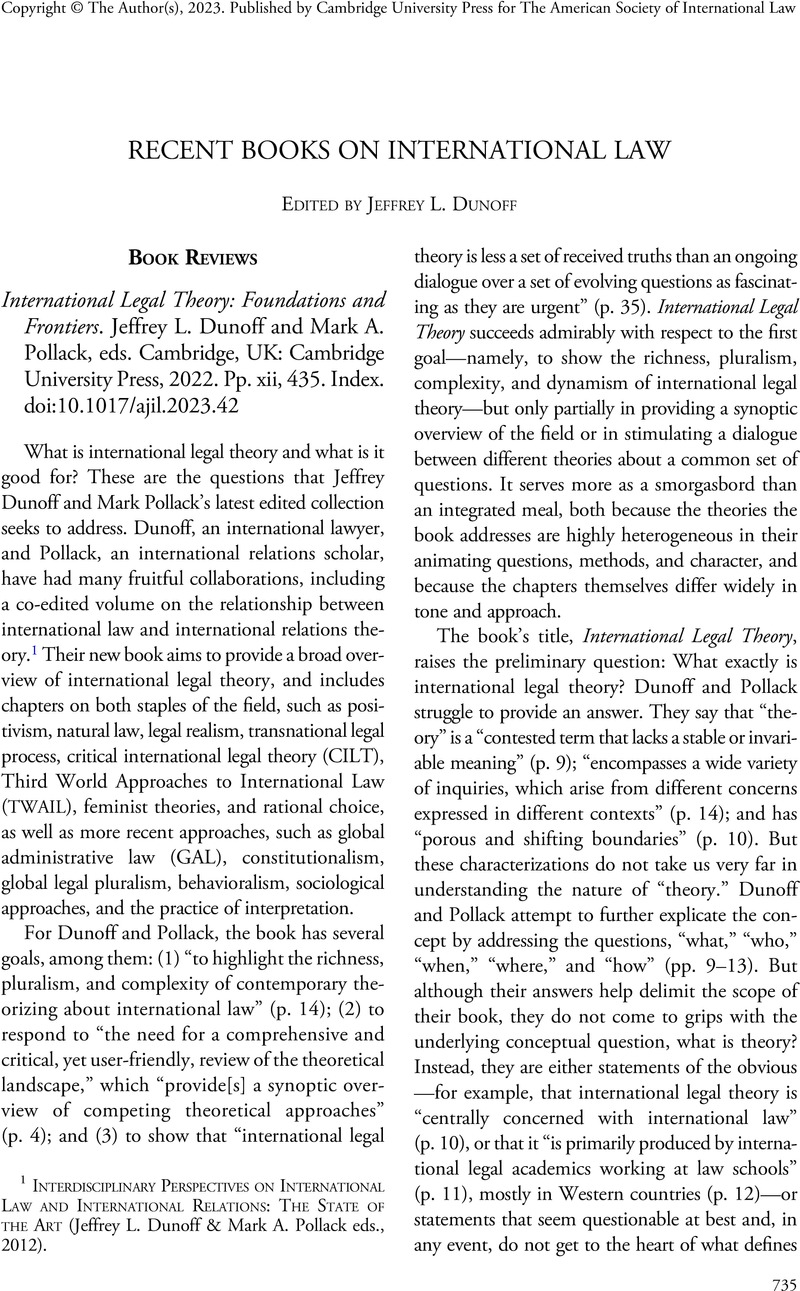No CrossRef data available.
Article contents
International Legal Theory: Foundations and Frontiers. Jeffrey L. Dunoff and Mark A. Pollack, eds. Cambridge, UK: Cambridge University Press, 2022. Pp. xii, 435. Index.
Review products
Published online by Cambridge University Press: 30 October 2023
Abstract

- Type
- Book Reviews
- Information
- Copyright
- Copyright © The Author(s), 2023. Published by Cambridge University Press for The American Society of International Law
Footnotes
Pursuant to the Journal's recusal policies, Professor Jeffrey L. Dunoff took no part in this review. The review was commissioned and edited by Professor Monica Hakimi, Co-Editor in Chief of the Journal.
References
1 Interdisciplinary Perspectives on International Law and International Relations: The State of the Art (Jeffrey L. Dunoff & Mark A. Pollack eds., 2012).
2 As Dunoff and Pollack note, “at its core international legal theory ‘asks general questions about the nature and role of law in the international world’” (p. 14, quoting Martti Koskenniemi).
3 Gardner, John, Legal Positivism: 5½ Myths, 46 Am. J. Juris. 199 (2001)CrossRefGoogle Scholar.
4 Karl Marx, Selected Writings 101 (Lawrence H. Simon ed., 1994) (emphasis in original).
5 See, for example, d'Aspremont's claims that international legal positivism “constitutes one of these central anti-models around which an argumentative community like international law articulates itself” (p. 75), that “international legal positivism plays the role of the anti-model that is necessary for theoretical debates to sustain their adversarial thrust” (p. 76), or that international legal positivism is “the adversarial construction without which the discipline could not construct itself” (p. 77).
6 In a similar vein, Koh argues for the transnational legal processes of interaction, interpretation, and internalization as the “best strategies to promote compliance” with international law (p. 120) and advocates that states pursue their national interests using “international law as smart power” (p. 121).
7 As Krisch argues: “Formal international law is . . . only one part of the picture, and retaining it as the sole focus of attention . . . would mean losing sight of its place in the broader complex of postnational, or global, law” (p. 248).
8 For example, Venzke sounds very much like a legal realist when he writes: “Choices for one interpretative stance rather than another are frequently subordinate to the overriding goal of defending a certain claim with the maximum available plausibility in the eyes of the relevant audience” (p. 314). Or when he states: “Interpreters are invested in a struggle in which they seek to align the law with their interests or convictions. They seek to pull the law onto their side” (p. 315).
9 According to Shaffer, the new legal realism “attends empirically and pragmatically to external political, economic, social and cultural factors that shape law as a going institution” (p. 84).
10 Edward H. Levi, An Introduction to Legal Reasoning (1949).
11 Anne van Aaken also says that a behavioralist approach “does not exclude normative, doctrinal or analytical reasoning” (p. 264).
12 Holmes, Oliver Wendell Jr., The Path of the Law, 10 Harv. L. Rev. 457, 469 (1897)Google Scholar.




